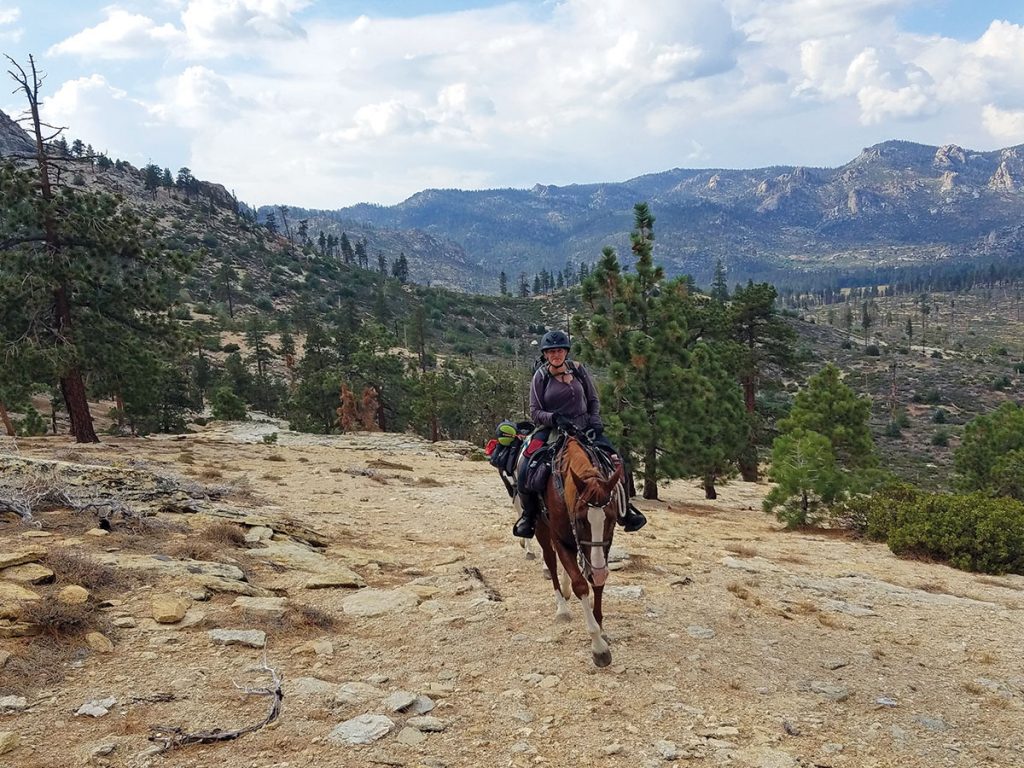
By Horsetrader staff
NORCO—It’s a Friday afternoon, and Mike Williams returns home to Fourth Street with his 16.1-hand Mustang gelding, Cowboy, after a day of what he loves most—trail riding.
This breezy January ride went 20 miles, a perfect distance to get Cowboy ready for an upcoming 300-mile journey that he and others have been planning for more than a year. The three-week trip, leaving Norco April 30 and arriving at Bishop May 21, will take Williams and co-riders Rebekah Wan and Ray Spence along urban routes out of Horsetown USA, up and beyond the Cajon Pass, across the Mojave Desert and ultimately into Owens Valley along the Eastern Sierra.
“It’s been a while since I’ve ridden that far,” Williams admits after his workout. “Usually, I’m six-to-10 miles and I’m done.”
Cowboy was a little tired, too, but also fine. “He just was not used to it,” says Williams. “By the time we get into this—day in and day out—it won’t be a problem for us.”
Conditioning is a key part of an extended ride, and this one is the longest ever undertaken by Williams, an avid Backcountry Horsemen member whose list of credentials include San Bernardino County search-and-rescue certification, FEMA large animal rescue and Wilderness First Responder. The first three days, from Norco to Phelan, will average more than 20 miles a day before the first layover, after which another three-day stretch to Red Mountain will be slightly longer. All told, the short days will be 15 to 16 miles; the long ones, 25 to 26.
Wan, a BCH member whose younger years were spent in a dressage saddle and on jumpers as well as on the trail and in horse camps, has ample experience to join this trip. Like Williams and Spence, trail riding and wilderness are part of her, thanks to a lifelong exposure to them, and like her partners, she wants to educate and inspire others to hit the trail.
“My favorite speed is three miles per hour,” says Williams, whose living room walls are adorned with scenic photos of himself, his wife, Sigrid, and their horses in spectacular settings accessible only by trail. “I really enjoy taking everything in—the land, the scenery. Good day, bad day, windy, rainy—it doesn’t matter. I just like it all.”
The riders also share a heartfelt bond to save trails for horses. The adage “use them or lose them” holds true—whether the pressure comes from developers in urban areas or cuts into public land access.
“The trails probably will always be there, but the question will be, who gets access?,” said Wan, Administrator at SoCal Equine Hospital in Norco where her husband, Paul Y. Wan, DVM, practices. “The last 10 or 15 years, it’s been a battle. I hope our ride brings awareness that these trails are needed for equestrians.”
“We’re having a lot of problems with public lands,” adds Williams. “A lot of people don’t even know they are there.”
Founded in 1973, Back Country Horsemen of America now has 194 state and local chapters nationwide with a clear mission: keep trails open on public lands. Keeping trails involves maintaining them, and in 2017, BCHA volunteers spent 324,154 hours working on trails in public lands.
“To keep the trails open, we need to help,” says Williams. “We cannot depend on the government to do all this. They can’t afford it.”
Education also drives Wan, who sees teaching as a tool to get horsepeople out on the trails more.
“The two biggest things Mike and I would like to see from this ride are awareness and education,” says Wan, who conducts regular horse-health community workshops at her equine hospital. “Riders may need to ask about safety or first aid in the backcountry, or other obstacles they may possibly encounter. I think that’s something that keeps people from doing it, and teaching them the preparedness and being able to stay safe will break down some of the barriers for those who may not be confident that they can do it.”
Whether for a one-day wilderness ride or for a 300-mile journey to Bishop Mule Days from Norco, planning is key. The support team behind this trip is well-prepared, featuring the spouses and Elaine Bailey, who’ll spearhead the ground crew.
Williams and Wan will garner lessons from this expedition, too. Both are putting in for the Wilderness Riders program that trains stock users about the value of wild lands and the importance of Gentle Use / Leave No Trace Skills.
“It’s going to educate us and it’s going to allow us to share with other people what it means to be a wilderness rider or a ‘leave-no-trace’ expert in the backcountry.
“It also will show our friends and other people that we’re capable of doing this—and that anyone can do this, too,” he smiled.
More online: http://bit.ly/902BCHC
Leave a Comment
All fields must be filled in to leave a message.